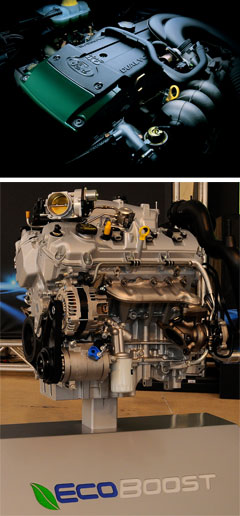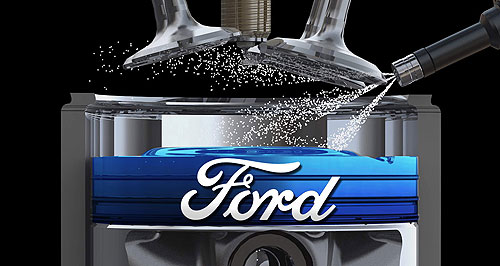Make / Model Search
Future models - Ford - FalconFord Falcon EcoBoostedLittle squirt: Ford's direct-injection EcoBoost technology promises more bang per litre. Falcon to plug in to global Ford plan with direct-injection 2.0-litre EcoBoost27 Jul 2009 FORD Australia's plan to embrace Ford’s ‘One Ford’ global strategy will become a reality in less than two weeks as it begins testing the ground-breaking new 2.0-litre turbocharged direct-injection four-cylinder EcoBoost engine in the Australian-built Falcon. Ford locked in the Falcon’s future engine strategy on Friday, just three days after the EcoBoost engine – the headline act in the new Falcon driveline line-up – was officially confirmed in Dearborn last week. In doing so, Ford Australia honoured a promise made in June to confirm the Falcon powertrain future by the end of July. Yet to be officially earmarked for any US model but now confirmed to power Ford Australia’s first four-cylinder Falcon in 2011, the EcoBoost turbo-four will make its global rear-wheel drive debut in the Falcon. That’s no big deal since the Falcon is one of the few remaining rear-drive models in the Blue Oval world, but it places Australia’s fourth most popular car firmly within Ford Motor Company president Alan Mulally’s ‘One Ford’ strategy, central to which is more global component sharing.  Left: Ford's E-Gas LPG engine. Below: Ford's EcoBoost V6. Left: Ford's E-Gas LPG engine. Below: Ford's EcoBoost V6.One Ford also aims to take a “leadership role” on fuel consumption, and the new turbo-petrol four is a cornerstone in FoMoCo’s quest to meet strict new European emissions and US fleet-average fuel consumption regulations. The company plans to improve its corporate average fuel economy (CAFE) by 20 per cent between 2005 and 2010, and by more than 35 per cent before 2015. To that end, Ford aims to produce 750,000 EcoBoost vehicles a year in the US and 1.3 million globally by 2012, including the Ford Taurus SHO and Flex, and Lincoln MKS MKT, which were made available in North America this year with a twin-turbocharged (Duratec) 3.5-litre EcoBoost V6. By 2013, Ford expects more than 90 per cent of its US model line-up to feature EcoBoost engine technology, which is claimed to offer the power and torque of a larger-capacity naturally-aspirated engine while cutting fuel consumption by 20 per cent and greenhouse gas emissions by 15 per cent. “Today we see it as a premium engine,” said Ford’s global vice-president for product development Derrick Kuzak. “As we expand it will be the volume engine.” Also tipped to power Ford’s next Escape SUV and the 2012 Mustang (in an all-turbo range that also should also include the EcoBoost V6), the force-fed inline four is confirmed only for the Falcon at this stage for Australia – despite being designed primarily for smaller vehicles, including the Focus and Mondeo. It will become available across the Falcon range, starting with the luxury G6E flagship. Ford said its first EcoBoost-equipped Falcon would be ready for testing in two weeks, but the rear-drive large sedan, wagon and perhaps even ute will require extensive re-engineering to accommodate it with either a six-speed Powershift twin-clutch automated manual transmission from the Focus or the Falcon’s six-speed ZF automatic. Ford had already committed to extending the life of its venerable 4.0-litre inline six (including a new liquid-injection LPG version in 2010, which has been forecast to account for up to 40 per cent of Falcon sales) beyond Euro IV for up to five years, when the government is expected to mandate the even tighter Euro V emission limit. And although it will arrive a year later than Ford promised in April, diesel power has now been confirmed for a 2011 arrival in the Territory (but not the Falcon), in the form of Jaguar Land Rover’s 2.7-litre turbo-diesel engine. It will be Ford Australia’s first diesel, first imported six-cylinder and first V6 - since the Capri 3000GT sold here between 1969 and '72. But confirmation of a successor for Ford’s current 5.4-litre V8, which does not meet next July’s Euro IV emissions standard and may – or may not – be replaced by a new US-built ‘Coyote’ 5.0-litre V8, was conspicuous by its absence at last week’s surprise Ford announcement. Four-cylinder engines displacing 2.0 or even 1.8 litres are commonplace in Europe in Falcon-sized vehicles. Ford has come close to releasing a four-cylinder Falcon before and Australian president Marin Burela has previously admitted to having reservations about downsizing the engine in his company’s top-seller. Asked in March about the chances of a four-cylinder Falcon, he said: “It is hard to say because once again you have the ratio of engine capability for the size of the vehicle and also how are you going to communicate the capability?“It is really interesting because in Australia, people are very focused on the size of engines, the cubes ... whereas in other parts of the world there has been a change there. Whatever we decide to do, we just need to make sure we can communicate that credibility.” Engine downsizing is what GM Holden is expected to do this year with its top-selling model and Falcon arch-rival, the Commodore, as part of a major upgrade that could comprise its smallest engine in more than 20 years. Expected to displace just 3.0 litres, the direct-injection alloy V6 could be assisted by weight-saving measures including aluminium body panels. Holden is also developing a new dedicated-LPG V6 and has committed to releasing an E85-compatible ethanol V6 for the Commodore in 2010. But even in the heavier Falcon, the smaller-displacement turbo engine, which should be about 60kg lighter than its cast-iron straight six, all but matches the outputs of Holden’s current entry-level Commodore (175kW and 325Nm) and should have the performance to be competitive with its closest rival. Ford has revealed minimum performance outputs of 230hp (170kW) and 240lb-ft (325Nm) of torque between 1500 and 5500rpm, along with a “10 to 20 per cent” reduction in CO2 emissions versus an advanced 3.0-litre petrol V6. In terms of efficiency, the EcoBoost Falcon will undercut the fuel consumption of the six-cylinder Falcon and Toyota Aurion, which are Australia’s most economical home-grown large cars at 9.9L/100km. The 3.6-litre Commodore averages at least 10.6L/100km, while both Hyundai’s 3.8-litre Grandeur V6 and Nissan’s new 3.5-litre Maxima V6 both return 10.8L/100km. But it remains to be seen if the four-pot Falcon will eclipse this year’s more economical Commodore, which could undercut the 9.0L/100km mark. Currently Australia’s most frugal large car is Skoda’s Superb 2.0 TDI turbo-diesel (125kW/350Nm, 6.9L/100km), ahead of the Grandeur 2.2 CRDi turbo-diesel (114kW/343Nm, 7.9L/100km), Superb 1.8 TSI turbo-petrol (118kW/240Nm, 8.4L/100km) and Honda Accord VTi 2.4 petrol (133kW/222Nm, 8.8L/100km). First revealed under the name TwinForce when it debuted in the 2007 Lincoln MKR concept, Ford’s patented EcoBoost induction technology combines direct petrol injection with turbocharging and precise electronic engine management. The MKR’s E85 ethanol-capable V6 offered a 6.0-litre V8-like 309kW and 542Nm and also appeared in the 2008 MKT concept under the EcoBoost banner. The Duratec-based EcoBoost V6 made its production debut in this year’s MY10 Taurus SHO with 265kW and 475Nm, but in the 2010 Flex, MKS and MKT makes 265kW/475Nm. Had Ford Australia not reversed a decision to replace the Falcon’s inline six with an imported V6, it would likely have powered the next XR6 and G6E Turbo. The four-cylinder version is the first EcoBoost engine to also feature Twin-Independent Variable Cam Timing (Ti-VCT), a simpler version of which features on the Lincoln MKT’s naturally-aspirated (205kW) 3.7-litre V6 iVCT engine. It is similar in specification to small-capacity turbocharged engines from European makers like the Volkswagen Group, PSA Peugeot-Citroen and now Mercedes-Benz. Rather than employ the proven direct-injection 2.3-litre DISI turbo four from Mazda, which Ford no longer controls, Ford plans a family of inline EcoBoost engines of its own, as previewed by the 1.6-litre EcoBoost engine in the 134kW/244Nm Lincoln C Concept at the Detroit show in January. The same engine powered Volvo’s S60 concept at the same show, under the name of GTDi (Gasoline Turbocharged Direct injection) and even smaller versions are possible to match, for example, VW’s new 1.2 TSI engine that packs 77kW/175Nm – more than its regular 1.6-litre engine. While the all-alloy DOHC EcoBoost V6, which employs two Honeywell-Garrett GT15 turbochargers and a fuel system co-developed with Bosch, is built at Ford’s Cleveland engine plant in Ohio, the EcoBoost inline four will be made at Ford’s Cologne, Craiova and Valencia engine plants in Europe by the end of this year. EcoBoost technology also features on a 5.0-litre dual-fuel V8 codenamed Bobcat, which was co-developed with Massachusetts company Ethanol Boosting Systems before being unveiled by the US department of energy and Society of Automotive Engineers in April. Ford is also working on new hybrid drive systems for the Focus and Escape, but says petrol-electric technology continues to have a traditional payback period of up between eight and 10 years (depending on fuel prices), compared with just two for EcoBoost. Claimed outputs of 205kW and 380Nm – which are comparable with the Falcon’s current 195kW/391Nm big-six – from the 2.0-litre EcoBoost engine in Ford’s 2008 Explorer America concept give a clue to the potential of the newest Falcon engine, but Ford Australia has ruled out a performance version for the Falcon. That should remain the domain of Ford’s locally-built inline turbo six for at least as long as the current Falcon’s life cycle (which could end before Euro V arrives), but four and six-cylinder EcoBoost engines are likely to power on into the next-generation Falcon – whether it continues to be rear-wheel drive or not. Ford may have abandoned its plan to manufacture the Focus at Broadmeadows – and with it the ability to also manufacture cars like the S-Max, Kuga and even Mondeo in Australia. But if the new turbo-four can help the Falcon tap more fleet deals and tempt back private buyers, EcoBoost could well have a long career ahead of it in the Falcon.  Read more27th of July 2009  Falcon ‘four’ guns for fleetsFord aims to recapture fleet business with fuel-friendly EcoBoost four-cylinderAll future models Alfa Romeo Alfa Romeo Abarth Abarth Alpine Alpine Alpina Alpina Audi Audi Aston Martin Aston Martin BMW BMW Bentley Bentley Chery Chery Brabham Brabham Chrysler Chrysler Chevrolet Chevrolet Cupra Cupra Citroen Citroen DS DS Dodge Dodge Fiat Fiat Ferrari Ferrari Foton Foton Ford Ford Great Wall Great Wall FPV FPV Haval Haval GWM GWM Honda Honda Holden Holden Hummer Hummer HSV HSV Infiniti Infiniti Hyundai Hyundai Jaguar Jaguar Isuzu Isuzu Kia Kia Jeep Jeep Land Rover Land Rover Lamborghini Lamborghini Lexus Lexus LDV LDV Mahindra Mahindra Lotus Lotus Mazda Mazda Maserati Maserati Mercedes-AMG Mercedes-AMG McLaren McLaren MG MG Mercedes-Benz Mercedes-Benz Mitsubishi Mitsubishi Mini Mini Opel Opel Nissan Nissan Peugeot Peugeot Pagani Pagani Proton Proton Porsche Porsche Renault Renault Ram Ram Rover Rover Rolls-Royce Rolls-Royce Skoda Skoda Saab Saab SsangYong SsangYong Smart Smart Suzuki Suzuki Subaru Subaru Toyota Toyota Tesla Tesla Volvo VolvoMotor industry news |
Click to shareFord modelsResearch Ford All future models Alfa Romeo Alfa Romeo Abarth Abarth Alpine Alpine Alpina Alpina Audi Audi Aston Martin Aston Martin BMW BMW Bentley Bentley Chery Chery Brabham Brabham Chrysler Chrysler Chevrolet Chevrolet Cupra Cupra Citroen Citroen DS DS Dodge Dodge Fiat Fiat Ferrari Ferrari Foton Foton Ford Ford Great Wall Great Wall FPV FPV Haval Haval GWM GWM Honda Honda Holden Holden Hummer Hummer HSV HSV Infiniti Infiniti Hyundai Hyundai Jaguar Jaguar Isuzu Isuzu Kia Kia Jeep Jeep Land Rover Land Rover Lamborghini Lamborghini Lexus Lexus LDV LDV Mahindra Mahindra Lotus Lotus Mazda Mazda Maserati Maserati Mercedes-AMG Mercedes-AMG McLaren McLaren MG MG Mercedes-Benz Mercedes-Benz Mitsubishi Mitsubishi Mini Mini Opel Opel Nissan Nissan Peugeot Peugeot Pagani Pagani Proton Proton Porsche Porsche Renault Renault Ram Ram Rover Rover Rolls-Royce Rolls-Royce Skoda Skoda Saab Saab SsangYong SsangYong Smart Smart Suzuki Suzuki Subaru Subaru Toyota Toyota Tesla Tesla Volvo VolvoMotor industry news |











Facebook Twitter Instagram